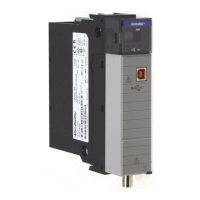Publication 1756-RM084F-EN-P - July 2002
7-14 Entering Sequential Function Chart Logic
Entering Transitions
Transitions follow this format:
TRANSITION (
ID := <
unique_identifier
>,
X := <
internal_grid_x_location
>,
Y := <
internal_grid_y_location
>,
Operand := <
tag_reference
>,
HideDescription := <yes|no>,
DescriptionX := <
numerical_value
>,
DescriptionY := <
numerical_value
>,
DescriptionWidth := <
numerical_value
>,
Force := <TRUE|FALSE>)
<CONDITION_block>
END_TRANSITION
Where:
Item: Identifies:
ID
the transition identifier. This ID uniquely identifies this transition from all other blocks.
Enter an unsigned, 32-bit integer value.
Specify:
ID :=
number
X
x-coordinate on internal grid. Enter an unsigned, 32-bit integer value.
Specify:
X :=
number
Y
y-coordinate on internal grid. Enter an unsigned, 32-bit integer value.
Specify:
Y :=
number
Operand
the transition tag. Enter a boolean tag. The import process uses this tag name to name
the transition.
Specify:
Operand :=
tag
HideDescription
whether or not to hide the transition description. Enter Yes or No.
Specify: HideDescription :=
text
DescriptionX
x-coordinate on internal grid of the description box. Enter an unsigned, 32-bit integer
value.
Specify:
DescriptionX :=
number
DescriptionY
y-coordinate on internal grid of the description box. Enter unsigned, 32-bit integer value.
Specify:
DescriptionY :=
number
DescriptionWidth
this attribute is not currently used; it is there for future use. Enter 0.
Specify:
DescriptionWidth := 0
Force
the transition is forced. Enter TRUE for forced true (set) or enter FALSE for forced false
(cleared). If the transition is not forced, do not enter this attribute.
Specify:
Force :=
text
CONDITION_block
the condition to evaluate for the transition.
see page 7-15

